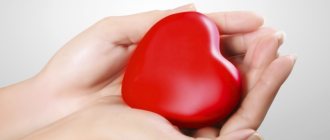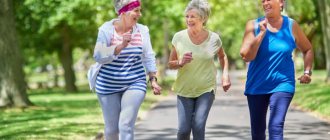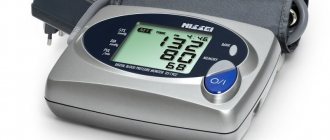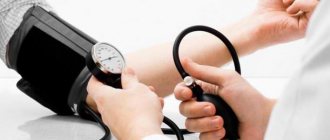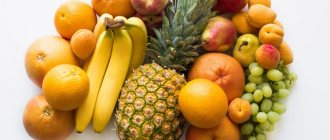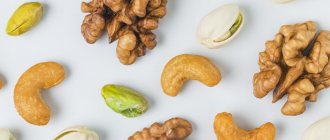Hypotension: useful tips for normalizing well-being
Hypotension is low blood pressure. Hypotension is a condition in which blood pressure drops below 100/60 mmHg. in men and below 95/60 mm Hg. among women. For older people, blood pressure is below 105/65 mmHg. is already considered reduced.
A tendency to low blood pressure is usually observed from childhood. Such children are lethargic, inactive, and quickly get tired of playing with their peers. Hypotensive adults are characterized by a so-called asthenic constitution - tall height and low weight. Most of them are thin people with pale skin.
Causes of hypotension
The most common cause of hypotension is autonomic vascular dysfunction and pathology of the endocrine glands. Separately, atherosclerotic hypotension is distinguished. This condition is observed in elderly people whose blood vessels are affected by atherosclerosis. Their walls lose elasticity and stop responding to impulses from the autonomic system. The contractile function of the heart also decreases; it pumps blood poorly. Blood pressure may decrease with anemia. This condition is associated with a decrease in hemoglobin content and the number of red blood cells in the blood, which often occurs when there is insufficient intake of iron into the body. The detection of iron deficiency anemia in old age deserves special attention. In these cases, a thorough examination is necessary to exclude a tumor of the gastrointestinal tract, small but regular bleeding from which can lead to the development of this form of anemia. In older men, hypotension often takes an orthostatic form, which is characterized by a sharp drop in blood pressure when the body is transferred from a horizontal to a vertical position. In this case, fainting and convulsions may occur, patients feel weakness in the muscles, noise and “emptiness in the head.” Worsening of health is more often observed in the mornings, in warm weather, after exercise and eating. Doctors believe that this condition is associated with age-related changes in various parts of the peripheral nervous system.
Main signs of hypotension
Manifestations of hypotension: pain and a feeling of heaviness in the back of the head in the morning, accompanied by dizziness and nausea, weakness, fatigue, decreased mood, palpitations and a feeling of interruptions in the heart, lack of air during physical activity. People with low blood pressure often experience coldness and numbness in their hands and feet, and increased sensitivity to heat and cold. Many people complain of sleep disorders.
Emergency care for acute drop in blood pressure:
- the person should be put down as quickly as possible, since in this position the blood supply to the brain is facilitated;
- the head should be positioned as low as possible, do not put a pillow on it;
- if it is not possible to lay a person down, you should sit him down with his head as low as possible between his knees;
— vapors of essential oils have a beneficial effect: just bring a bottle of rosemary and camphor oils or peppermint oil to a person’s nose.
Nutrition tips
A plant such as celery has the ability to increase blood pressure. Patients are recommended to add chopped celery roots to vegetable salads. Among fruits, strawberries have this ability; they can be eaten in large quantities. For hypotension, it is preferable to use vegetable oils in the diet: sunflower, corn, olive, peanut, soybean. From animal fats you can eat butter, cream, sour cream. Lard, beef and lamb fat are not recommended. Recommended foods include nuts, sunflower seeds, and oatmeal. If your health allows and there are no contraindications, you can drink coffee and chocolate. It is important to follow a diet. You need to eat at approximately the same time, at least 4 times a day, in small portions.
Diet for low blood pressure
Meals should be complete, balanced, satisfying. Skipping breakfast is unacceptable; only a hearty meal will give you energy for the first half of the day. Make your breakfast menu in the “English style”; an excellent choice would be:
- scrambled eggs and ham;
- a cheese sandwich;
- strong sweet coffee.
At your next meals, eat foods that will help your body maintain tone.
Table - list of foods that increase blood pressure
| № | Product |
| 1. | Coffee |
| 2. | Green tea |
| 3. | Hibiscus |
| 4. | Freshly squeezed juice |
| 5. | Low-fat cheese |
| 6. | Lean ham |
| 7. | Beef |
| 8. | Chicken |
| 9. | Turkey |
| 10. | Fatty fish |
| 11. | Milk |
| 12. | Cottage cheese |
| 13. | Sour cream |
| 14. | Kefir |
| 15. | Yogurt |
| 16. | By-products (kidneys, liver, brains) |
| 17. | Eggs |
| 18. | Bran bread |
| 19. | Carrot |
| 20. | Sorrel |
| 21. | Bananas |
| 22. | Oranges |
| 23. | Lemons |
| 24. | Pineapples |
| 25. | Bell Pepper |
| 26. | Berries |
| 27. | Boiled potatoes |
| 28. | Corn |
| 29. | Millet |
| 30. | Brown rice |
| 31. | Buckwheat |
| 32. | Oatmeal |
| 33. | Pearl barley |
| 34. | Spinach |
| 35. | Nuts |
| 36. | Lightly salted cucumbers |
| 37. | Turmeric |
| 38. | Curry |
| 39. | Basil |
| 40. | Cardamom |
| 41. | Bay leaf |
| 42. | Cinnamon |
| 43. | Chilli |
It is important to include complete sources of protein (meat, fish, dairy products) in your food list. They provide a long-lasting feeling of satiety, and as long as the body digests nourishing food, attacks of weakness do not threaten. Dairy products, cheeses, and meats increase cholesterol levels for a short time, which also gives the body strength.
Combine protein foods with vegetables and fruits high in flavonoids and ascorbic acid. Vitamin C, characteristic of sour fruits and berries, tones blood vessels and strengthens the vascular wall. All types of leafy vegetables are beneficial, as are brightly colored fruits.
Japanese scientists have proven that eating red, yellow and green vegetables tones the body no worse than coffee. The brighter the fruit, the better the blood pressure rises, and at the moment when a person simply looks at it.
Include starchy foods, cereals, and nuts in your diet. They saturate well and increase hemoglobin levels.
Table - dangerous products that increase blood pressure
| 1. | Fat meat |
| 2. | Sausage |
| 3. | Pickled vegetables |
| 4. | Smoked fish, meat |
| 5. | Baked goods made from refined wheat flour |
| 6. | Confectionery |
| 7. | Bakery products |
| 8. | Chips |
| 9. | Salads with mayonnaise |
| 10. | Packaged juices |
| 11. | Sweet carbonated drinks |
These foods contain large amounts of salt, sugar or fat. They improve the condition in the short term, but cause more harm to the body.
Five rules for eating hypotension
When preparing your diet, follow these rules.
- Do not abuse sweet, salty, fatty foods. Its effect is short-term, while the risk of developing obesity, vascular atherosclerosis, and hypertension is high.
- Look for healthy alternatives . Instead of chips, eat a handful of salted peanuts, instead of sweet sparkling water, drink a cup of Turkish coffee. There are many dishes that can keep blood pressure normal and not harm your health.
- Eat often . Optimally – five times a day. Main meals should be alternated with light snacks. For second breakfast and afternoon snack, choose nuts, dairy products, and fruits.
- Remember that food has a short-term effect . The effect lasts only while the food is being digested. Avoid pangs of hunger.
- Take emergency measures if the pressure drops too much . If you need to quickly bring yourself to your senses, take half a teaspoon of salt and slowly dissolve in your mouth. Use this method only when necessary.
Liquid has a greater hypertensive effect than food. Drinks invigorate faster and more pronouncedly, as they fill the blood vessels with liquid and tone them. Your “lifesavers”: strong coffee with sugar or salt (Turkish), loose leaf green tea, lemongrass drink with honey, freshly squeezed orange juice, rosehip infusion with honey or sugar.
Raise the tone
Many hypotensive people experience attacks of weakness and drowsiness in the middle of the day. In this situation, a simple exercise helps restore tone. Sit on a chair with your legs apart and your arms crossed behind your head. Take a deep breath and slowly bend towards your knees. Straighten up and exhale sharply. Repeat the exercise three times.
The best medicine for hypotension is sleep. Moreover, you need to sleep at least 9–11 hours a day!
If possible, try to take a walk outside for at least half an hour before going to bed. Don't sit too long in front of the computer or TV. To fall asleep faster, it is useful to do this procedure at night. Fill the bathtub with cool water to cover your ankles and walk in the water for a few minutes. Then rub your feet with a towel until they are warm, put on wool socks and go to bed.
A simple breathing exercise that needs to be performed 5-7 times without getting out of bed will help you get an extra boost of energy early in the morning. Lying on your back, inhale deeply, inflating your stomach, then exhale slowly - your stomach smoothly lowers and presses inward. This type of breathing improves blood flow and raises the tone of the nervous system.
When there is nowhere to fall lower...
If arterial hypotension (this is what doctors call low blood pressure) is secondary - that is, a “companion” of some underlying diseases (thyroid gland, adrenal glands, liver, nervous system, anemia...), the main thing will be treated. And if it is primary: the tonometer constantly shows 90/60, or even lower, it is believed that there is nothing wrong with it. Such hypotension is not life-threatening; it does not lead to heart attack or stroke, unlike hypertension. Moreover, according to scientific data, low blood pressure inhibits the development of atherosclerosis and increases life expectancy by an average of 10 years. In general, live and be happy! I just don’t have the strength to rejoice.
Diet and nutrition for high blood pressure and hypertension
Diet and proper nutrition for high blood pressure and hypertension are an integral part of the treatment of this disease. In most cases, high blood pressure can be reduced without resorting to pills - just by changing some of your habits and diet.
First. If you suffer from hypertension, you need to switch to a dairy-plant diet at least temporarily. Especially if you have high diastolic blood pressure .
Note from Dr. Evdokimenko.
Diastolic pressure is the lower pressure, that is, the second digit in the indicator. Let's say if your blood pressure is 130/80, then the top reading, 130, is the systolic pressure. And the lower figure, 80, is diastolic pressure. So, it is advisable for those who have high diastolic pressure, above 100-110 units, to follow a dairy-vegetable diet.
What is meant by this diet? Everything is very simple. Less meat, especially fatty meat. Less fatty fish. Although you can sometimes afford fatty sea fish - it contains fats that are beneficial for metabolism.
If possible, exclude fried, spicy, smoked foods, as well as sweets and baked goods from your diet. That is, almost everything is delicious.
But what is possible?
All types of vegetables are allowed, in any form - stewed, boiled, steamed. Those vegetables that are eaten raw can, of course, be eaten raw.
The diet must include fruits and berries. Porridges are healthy - buckwheat, oatmeal, rice. They need to be alternated. Wholemeal bread is healthy. And any low-fat dairy products.
Bran is very useful (they are generally useful for all forms of hypertension).
The only meat that is healthy is chicken, and even then boiled. And before cooking, be sure to cut off all visible fat from it.
You ask me: why endure such dietary restrictions?
First of all, for the sake of survival, since high diastolic pressure is much more likely than high systolic pressure to lead to severe heart attacks and strokes. Many times more often.
To complete the dietary topic, let's create a sample menu for a person with hypertension. So.
Ideal lunch for hypertensive patients:
The main dish (for satiety) is chicken breast. The breast can be replaced with a small amount of fish to compensate for the lack of potassium in the body. Choose what you like best - cod, hake or mackerel.
Garnish: baked jacket potatoes + seaweed. Or bean lobio. Or buckwheat. Or boiled rice. Or vegetables (in any form). Tomatoes, beets, radishes, and green onions are very useful.
For dessert - dried fruits: apricots, dried apricots, prunes, raisins. Or fresh fruits and berries - currants, grapes, apricots, peaches.
We wash it all down with water or tea, but best of all, compote or fruit drink. Just not purchased, but prepared yourself, at home. The best option is blueberry, cranberry or lingonberry juice.
As you can see, this is not a royal dinner. But you can live.
To reduce blood pressure, you need to eliminate potassium and magnesium deficiency
Very often, hypertension is caused by a lack of essential vitamins or microelements. And first of all - a lack of potassium and magnesium. Especially potassium.
It is even sadder that many drugs for lowering blood pressure, which have a diuretic effect, accelerate the loss of potassium and magnesium by the body. But smart doctors, of whom there are very few left in nature, will try to help the patient compensate for the deficiency of potassium and magnesium in the body.
This can be done with the help of useful tablets (you will be surprised, there are such) - with the help of asparkam or panangin.
But if we talk about potassium, perhaps the most important microelement for the heart and blood vessels, then it is better to compensate for its deficiency with the help of potassium-containing foods.
For reference. The largest amount of potassium (more than 0.5 g per 100 grams of food) is found in dried fruits - apricots, prunes, raisins. And also in peas, beans, seaweed. And in potatoes, especially baked ones in their jackets.
Relatively large amounts of potassium (up to 0.4 g per 100 grams of food) are found in cod, hake, mackerel, oatmeal, tomatoes, beets, radishes, green onions, currants, grapes, apricots and peaches. And also in beef and pork.
Slightly less potassium (about 0.25 g per 100 grams of food) is found in chicken, pike perch, millet, buckwheat, carrots, zucchini, pumpkin, strawberries, pears, plums and oranges.
We follow the water regime - drink water in the right quantities.
In observations of the majority of hypertensive patients, it was noticed that they drink any drinks - tea, coffee, beer, packaged juices, but drink very little plain still water.
And this is bad, because only plain water properly cleanses the kidneys and helps the kidneys remove various toxins and waste products from our body from the body. Coffee and beer, on the contrary, hinder the functioning of the kidneys; and juices and teas most often do not provide the “flushing” effect that ordinary still water can provide.
- But what do the kidneys have to do with it? - some readers will ask me. — Why did we talk about the fact that they need to be washed? We're not talking about kidneys, we're talking about blood pressure?
If you remember our conversation about the causes of hypertension, then remember that some kidney diseases lead to hypertension. In general, even the slightest deterioration in the condition of the kidneys can lead to a persistent increase in blood pressure. Therefore, the kidneys need to be helped, they need to be “flushed”, and you need to drink the required amount of water every day.
Question. How much water should you drink per day?
Some hotheads claim that you need to drink 2-3 liters of water per day. This, of course, is clearly overkill. This can also lead to water poisoning (yes, this happens). You need to drink about 1 liter of water per day—namely water, not coffee, tea, juices or beer.
If you want some other drinks in addition to water (the same teas, juices, coffee or beer), please drink them to your satisfaction, approximately at the rate of plus another liter of liquid per day. But no more.
Note from Dr. Evdokimenko. You can find out if you are drinking enough by taking a routine clinical blood test (finger prick). In this analysis there is such an indicator - hematocrit, which is often denoted by the English letters HCT.
So, if your hematocrit is elevated, you need to drink more water. And if it is low, on the contrary, you need to drink even less. However, such a decrease in hematocrit occurs quite rarely, mainly after severe bleeding and with anemia.
By the way, some hypertensive people believe that if you drink a lot of water, your blood pressure, on the contrary, will increase even more. Plus there will be swelling. Could this happen?
Certainly. But only if a person continues to consume excess salt. Salt immediately retains water in the body and increases blood pressure.
We've already talked about this here >> Remember: without reducing the amount of salt you consume, no other efforts to lower your blood pressure will help except poison (that is, pills)!
Chapter by Dr. Evdokimenko© from the book “BEING HEALTHY IN OUR COUNTRY.” All rights reserved.
READ MORE:
- All important articles about hypertension and high blood pressure
- Hypertension, arterial hypertension, high blood pressure: a very profitable disease!
- The first chapters of the book “Being healthy in our country”
- All articles by Dr. Evdokimenko
- Where to buy books by Dr. Evdokimenko
Lifestyle and daily routine
Good health is determined not only by nutrition, but also by lifestyle. Six recommendations from our expert, fitness trainer Nika Tyutyunnikova will help you forget about low blood pressure for a long time.
- Get enough sleep! The duration of night sleep should be at least eight hours. Decide what time you should go to bed in the evening and stick to it. Before going to bed, elevate your legs above your head (place them on a bolster, pillow or ball). And lie there for 10-15 minutes to ensure a rush of blood to the brain.
- Take a walk in the fresh air. Working in an office and lack of walking does not allow the blood to become saturated with oxygen. Ventilate the room regularly, open the windows slightly to allow fresh air to enter. Every evening, take non-tiring walks for 30-45 minutes.
- Take a contrast shower . It will help you quickly tone your body in the morning before work or cheer you up in the evening. Temperature changes should not be sudden. Alternate cool water with warm water.
- Drink water . The more fluid in the body, the lower the risk of loss of strength. Don't forget to drink up to one and a half liters of clean, still water throughout the day.
- Play sports . Find a type of physical activity that you enjoy and do it three to four times a week. Running, swimming, working out in the gym or Pilates at home - any type of physical exercise will be beneficial and will help blood vessels maintain tone.
- Experiment when preparing dishes . Russian cuisine uses “mild” spices, so take a closer look at Asian cuisine. There should be spicy and slightly spicy dishes on your table. Try adding curry, turmeric, chili pepper, and cardamom to roasts, fish and vegetable dishes. Drink coffee with cinnamon. New flavors will make familiar dishes interesting, tempting and invigorating. Plus, spices have a “fat-burning” effect: they increase metabolism and help fight fat deposits.
Do not intentionally over-salt your food; add salt to taste. Excessive salt consumption is dangerous.
Important
Fainting? You can warn me!
If you have low blood pressure, you are more likely to faint if you find yourself in a stuffy train or in a queue. Precursors of fainting are a sharp headache, rapid heartbeat, a feeling of lightheadedness... Try to sit down as quickly as possible (feel free to ask for a seat), lower your head below your knees, breathe evenly, but not deeply. And don't rush to get up when you feel better. Rest for half an hour.
Continued: Low blood pressure, what to do →
Where to begin?
With hypotension, the regulation of vascular tone is disrupted. For most “primary” hypotensive patients, this is a family trait. However, hypotension can also be triggered by chronic stress, overload, and lack of exercise. And sometimes there is a constant deficiency of vitamins E, C and group B.
Of course, if low blood pressure does not cause any problems, you can live with it. But this happens extremely rarely, and in order to properly help the sufferer, an examination is necessary. First - blood tests, urine tests, ECG, and if no special health problems are identified, then most likely you need to contact a cardiologist or neurologist for help. The doctor may prescribe Doppler echocardiography, cardiointervalography (allows us to identify the nature and severity of autonomic disorders).
Menu for the day
Products for increasing blood pressure can be tasty, healthy and invigorating at the same time. Menu option for one day from our expert, fitness trainer Nika Tyutyunnikova.
| Eating | Menu |
| Breakfast | Steam omelette with vegetables; sandwich with black bread and cheese; black tea with sugar |
| Lunch | A handful of nuts; banana; hibiscus |
| Dinner | Vegetable soup; buckwheat porridge with stewed turkey; coffee; piece of dark chocolate |
| Afternoon snack | A glass of yogurt (kefir) |
| Dinner | Baked mackerel; a fresh vegetable salad |
No pills!
Low blood pressure cannot be treated with regular medication. And there are few drugs themselves for this. Depending on your symptoms, such as headache attacks, your doctor may prescribe medications that contain caffeine. But they take the pills sporadically. The best option for hypotension is medicinal plants. Schisandra, Leuzea, Rhodiola rosea, and ginseng are good for toning blood vessels. The course of treatment is usually 3 weeks, then a break for a month, and the course must be repeated. Sometimes physiotherapy is also prescribed - aeroionotherapy (inhalation of air enriched with ozone), galvanic collar, darsonvalization...
For hypotension, vascular training is important: various types of therapeutic showers and baths, hydromassage, sauna. And also a contrast shower, but temperature changes should not be too sudden - you need to get used to them gradually.
And of course, movement is necessary - nothing better than this increases muscle and vascular tone.

